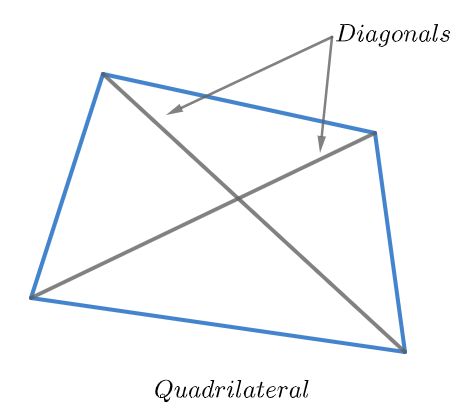
Fill in the blanks:
A quadrilateral has ____ diagonals?
Answer
419.7k+ views
Hint: For solving these problems, we need to have a clear understanding of geometry and type of figures or polygons. Along with these we should have a clear idea about the number of sides and diagonals in different polygons. Thus, we can easily identify the number of diagonals in a quadrilateral.
Complete step by step answer:
Euclid's method is the one that consists in assuming a small set of intuitively appealing axioms, and deducing many other propositions (theorems) from these. The Elements begins with plane geometry. In geometry, a polygon is a plane figure that is described by a finite number of straight-line segments connected to form a closed polygonal chain or polygonal circuit. The solid plane region, the bounding circuit, or the two together, may be called a polygon. The segments of a polygonal circuit are called its edges or sides, and the points where two edges meet are the polygon's vertices or corners. The interior of a solid polygon is sometimes called its body. An n-gon is a polygon with n sides; for example, a triangle is a three-gon with three sides and a quadrilateral is a four-gon with four sides. Thus, we can also say that a quadrilateral has four corners.
In geometry, a diagonal is a line segment joining two vertices of a polygon or polyhedron, when those vertices are not on the same edge. Informally, any sloping line is called diagonal.
Thus, in a quadrilateral, which consists of four corners, and diagonals can be drawn using the two corners which are not on the same side. This leaves us with two diagonals joining the opposite vertices. Hence, a quadrilateral has two diagonals.

Note: These kinds of problems are pretty easy to solve, but one needs to be careful otherwise small misjudgements can lead to a totally different answer. We also should keep in mind that the diagonals are lines joining corners on different sides and not on the same side itself.
Complete step by step answer:
Euclid's method is the one that consists in assuming a small set of intuitively appealing axioms, and deducing many other propositions (theorems) from these. The Elements begins with plane geometry. In geometry, a polygon is a plane figure that is described by a finite number of straight-line segments connected to form a closed polygonal chain or polygonal circuit. The solid plane region, the bounding circuit, or the two together, may be called a polygon. The segments of a polygonal circuit are called its edges or sides, and the points where two edges meet are the polygon's vertices or corners. The interior of a solid polygon is sometimes called its body. An n-gon is a polygon with n sides; for example, a triangle is a three-gon with three sides and a quadrilateral is a four-gon with four sides. Thus, we can also say that a quadrilateral has four corners.
In geometry, a diagonal is a line segment joining two vertices of a polygon or polyhedron, when those vertices are not on the same edge. Informally, any sloping line is called diagonal.
Thus, in a quadrilateral, which consists of four corners, and diagonals can be drawn using the two corners which are not on the same side. This leaves us with two diagonals joining the opposite vertices. Hence, a quadrilateral has two diagonals.

Note: These kinds of problems are pretty easy to solve, but one needs to be careful otherwise small misjudgements can lead to a totally different answer. We also should keep in mind that the diagonals are lines joining corners on different sides and not on the same side itself.
Recently Updated Pages
The correct geometry and hybridization for XeF4 are class 11 chemistry CBSE

Water softening by Clarks process uses ACalcium bicarbonate class 11 chemistry CBSE

With reference to graphite and diamond which of the class 11 chemistry CBSE

A certain household has consumed 250 units of energy class 11 physics CBSE

The lightest metal known is A beryllium B lithium C class 11 chemistry CBSE

What is the formula mass of the iodine molecule class 11 chemistry CBSE

Trending doubts
Draw an outline map of India and mark the following class 9 social science CBSE

Distinguish between Khadar and Bhangar class 9 social science CBSE

Write a short note on The Shiwalik Range class 9 social science CBSE

The radius of the base of a cone is 5 cm and its height class 9 maths CBSE

The president of the constituent assembly was A Dr class 9 social science CBSE

What are the major achievements of the UNO class 9 social science CBSE




